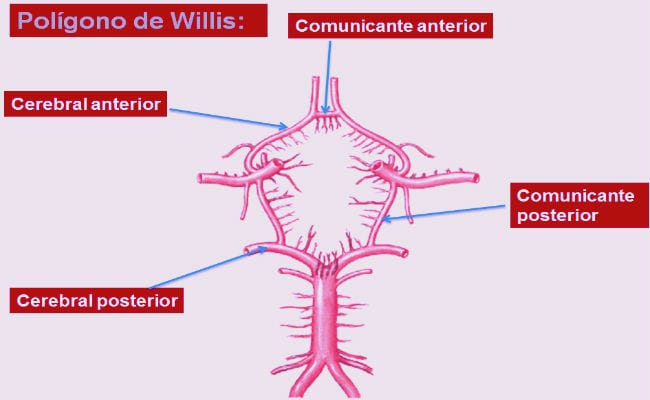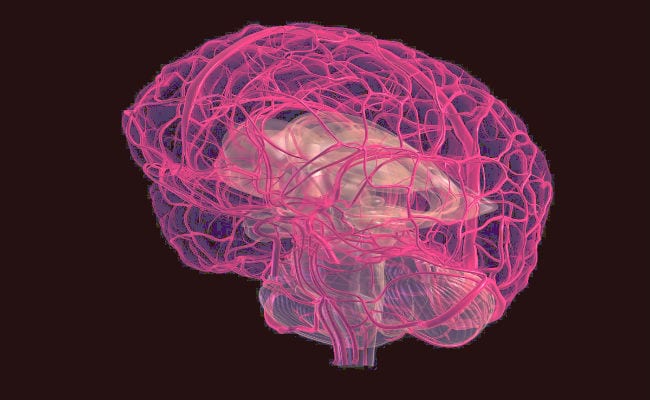The brain is the main organ of the central nervous system, it produces the mechanisms of translation of information, responses and control of structures. This structure is characterized by the fact that it does not have an energy storage system that allows it to function, which is why it is absolutely dependent on blood flow. Clinical studies have determined that it takes only 10 seconds of absence or decrease of blood flow (ischemia), for the individual to lose consciousness, and from 15 to 20 seconds, so that we observe important collateral effects in the individual.
By virtue of this, our body has a structure made up of a ring-shaped arterial system, whose primary function is to cushion pressure changes in the body, preventing blood flow to the brain from being altered. This network of arteries, known as polygon of Willis.

What is the polygon and how is it shaped?
The action of this structure was determined by the English neurologist Thomas Willis, who in the XNUMXth century was the first to point out its functioning, and its respective importance for the brain system. It consists of a structure, located in space leptomeningeal (subarachnoid) and it is an area of the brain space delimited by the arachnoid (intermediate meninge) and pia mater (internal meninge). The polygon of Willis, has a ring shape, and is made up of a set of vessels and arteries, whose main function is to regulate the flow of blood to the organs of the central nervous system, such as the brain and the encephalon.
The six main arteries, which are responsible for transporting blood to the brain, are united in a curious way, which has been compared to a hexagon, hence the polygonal denotation of the Willis structure. Although specialists in the area have emphasized that it is common in some patients without ischemic tendencies, to find this structure incomplete. Below we name the main arteries that make up this structure:
Main arteries that make up the circle of Willis:
Positioned in a closed circuit, the so-called hexagon of Willis is mainly made up of the following arteries:
Anterior communicating arteries (ACA): In the precommunical zone of the brain, this artery finds its origin, connecting the two anterior cerebral arteries, with an approximate length of 4 to 5 mm, although it is difficult to predict, because many variations in its approximate size have been observed. The conditions linked to this artery tend to alterations in the visual field.
Posterior communicating arteries (PCA): It is the communicating artery that originates from the anterior choroidal artery, and it is its responsibility to establish the connection between 3 arteries of the same cerebral hemisphere. The most common pathology that can develop in this structure is the posterior communicating artery aneurysm.
Ophthalmic artery: It goes from the anterior clinoid processes, feeding the optic nerve. It constitutes a collateral branch of the internal carotid artery.
External carotid artery: It is one of the main arteries located in the human brain, originating from the common carotid. This is the artery that allows us to take the carotid pulse, and it branches into six important bifurcations in terms of blood supply to higher structures.
Basilar artery: It is the famous artery originating at the vertebral junction of the right and left side, whose function is to transport oxygenated blood to the brain.
Importance of oxygenated blood for the brain
All organs require blood flow for their proper functioning, since this fluid is the main transport of nutrients and basic components, which all vital structures require for their proper development. In the case of the brain, the supply of oxygen transmitted by the blood is highly appreciated and allows it to function. And its importance is appreciable in the fact that just a few seconds without the usual supply of the vital fluid can translate into important affections in motor and cognitive areas of the individual (depending on the area where the failure occurs).
Mechanism of action of the hexagon of Willis

The Willis range is primarily responsible for carrying out the collateral circulation, which constitutes a preservation mechanism at the level of primordial structures of the central nervous system. Collateral circulation refers to the blood flow that is activated in situations in which the flow is altered (decreased or stopped), and although its action may not be able to replace the function of the arteries responsible for irrigation, This emergency system allows normal operation to be prolonged for a limited period of time, which helps to reduce the negative effects, while the patient accesses medical attention.
When a situation of vascular occlusion occurs, which affects the stability of blood flow in the brain structures, an increase in the resistance to flow is observed in the carotid and vertebral arteries, which is why a decrease in the pressure at the level occurs. of the Willis polygon which initiates damping actions, in an attempt to prolong the good functioning, for the longest period of time possible. The greater the magnitude of the anastomosis, the greater the collateral contribution of the vascular structures not involved in the occlusion. Under normal circumstances, these alternate conduits may remain inactive, or with very low use, in which no blood flow is perceived, but instead a blood movement is carried out, which is aimed at maintaining patency in the structure, thus avoiding pathologies such as thrombosis.
When the collateral blood supplies are not sufficient to satisfy the demand for irrigation in the territory that was supplied with blood by the obstructed artery, secondary mechanisms are put into action such as the dilation of the resistance vessels.
As you can see, the human body consists of a complex system, which is formed by structures that guarantee the balance of its functioning.
Associated pathologies
The narrowing, hardening and obstruction of arteries is the primary cause of pathologies developed at the level of the central nervous system, and that activate the functioning of the arterial structure of Willis. The main pathologies developed by arterial problems are listed below:
Thrombosis: It consists of a blood clot that generates an obstruction at the level of the arteries, which can lead to its rupture, the direct consequence of which is a hemorrhage.
Aneurysms: It consists of a weak area of the blood vessel, which leads to its inflammation, it is a serious condition that can lead to the death of the patient, since in cases of increased blood pressure, the rupture of the vessel can occur. Most aneurysms (according to clinical data greater than 80%) occur in the anterior part of the circle of Willis, so many doctors have concluded that the genetic part influences this affinity.
Cerebrovascular accident (CVA): It constitutes a heart attack or stroke, which leads to the death of most patients who experience it.